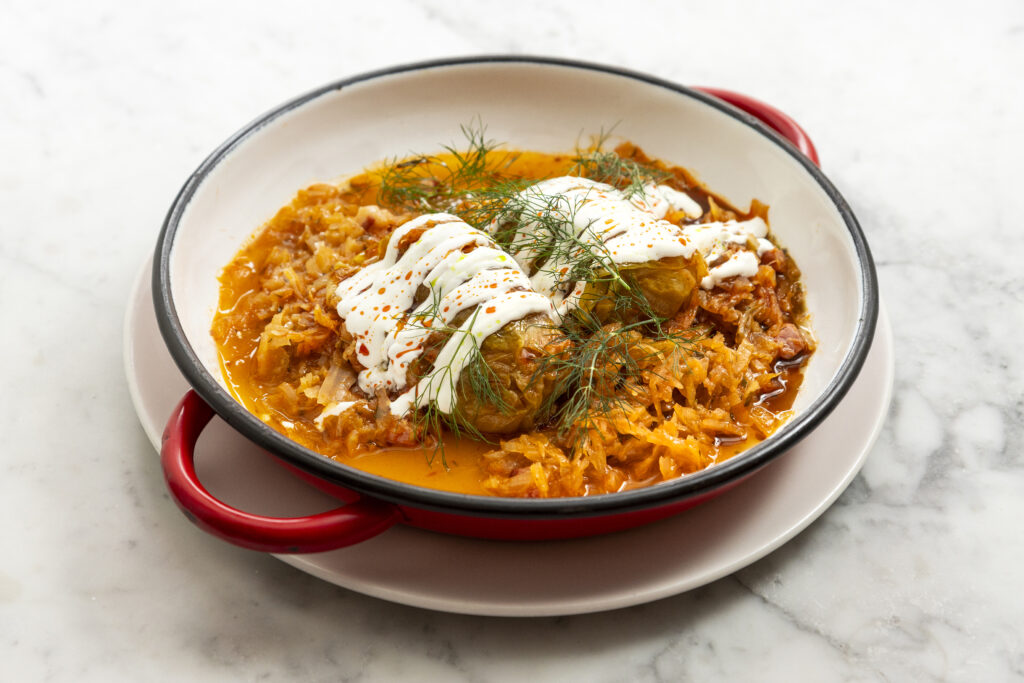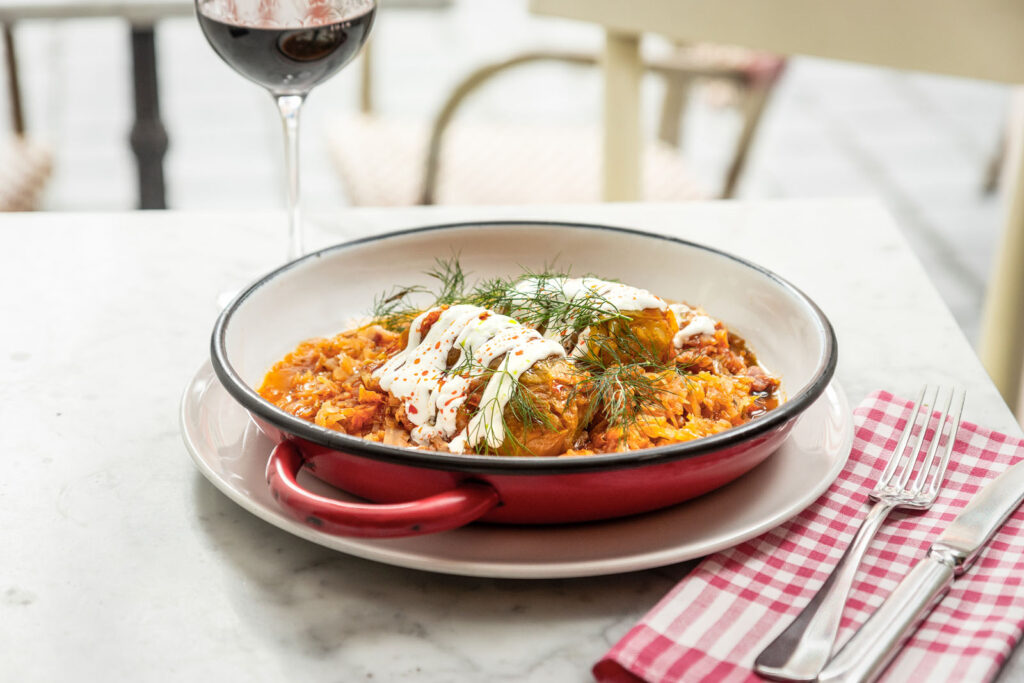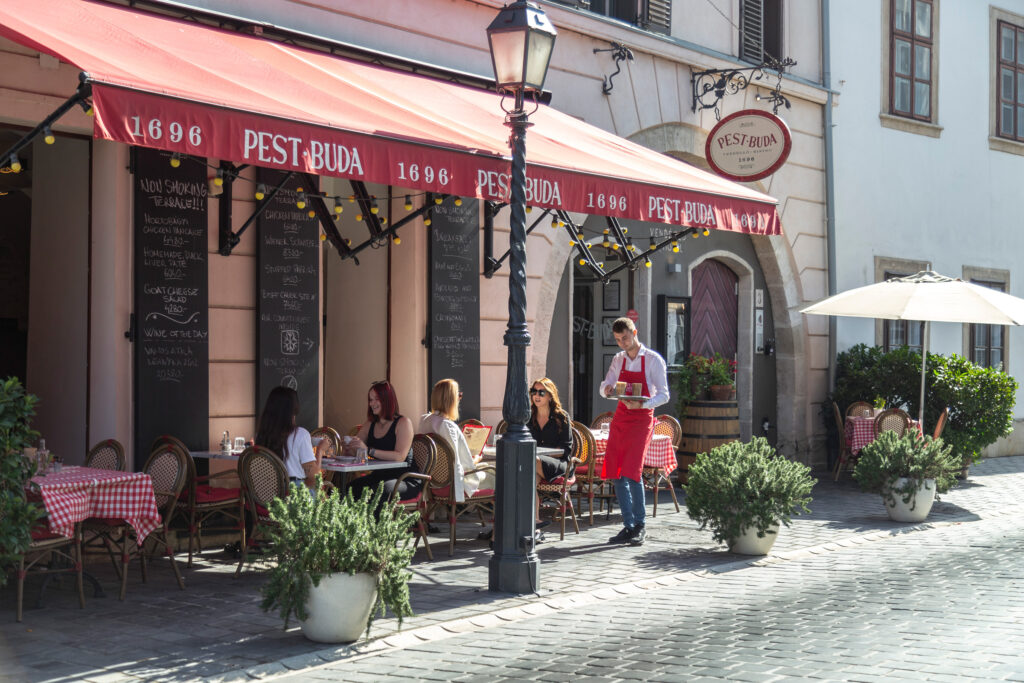Hungarian cuisine is a vibrant world of bold flavors shaped by agriculture, peasant roots, and centuries of outside influence. In Budapest, every dish tells a story, and Hungarian classics are now reimagined with modern presentation. Zsidai Group’s restaurants capture this spirit—where tradition meets innovation, and food becomes a way of life.
Why Is the Flavor of Hungarian Cuisine So Distinct?
One of the most defining characteristics of Hungarian cuisine is its intense, deep, and rich flavor palette. This doesn’t just come from the spices – such as paprika, pepper, or marjoram – but also from the tradition that dishes are “thick and hearty.” Soup is not just broth, but a full meal; a main course is not light, but filling.
This flavor profile is also connected to historical societal structure: peasant cuisine aimed to provide high-energy meals for people doing hard physical labor. This is how the key features of Hungarian cuisine developed in practice: fattier meats, thickened vegetable stews, creamy sauces, slow-cooked meals, and pickles on the side.
This tradition is now evolving; more Budapest restaurants are offering classic dishes in refreshed versions. The Zsidai Group’s Buda-based venues present familiar flavors with modern plating and updated ingredient quality.

The History of Hungarian Cuisine
To appreciate the rich diversity of Hungarian cuisine, consider the influences that have shaped it over the centuries. This culinary landscape is not static, but a dynamic, evolving tradition built incrementally – shaped by history, geography, and various cultures.
Medieval Roots: The Legacy of Nomadic and Shepherd Cultures
The nomadic lifestyle of the conquering Hungarians can still be felt in the characteristics of Hungarian cuisine today. Cooking in cauldrons, meat-based dishes, and hearty one-pot meals (such as goulash) all stem from the everyday life of shepherds. These meals were practical, easy to store, nourishing, and made from simple ingredients.
Turkish Influence: Stuffed Dishes, Spices, and Sweets
During the 150 years of Ottoman rule, ingredients and techniques arrived in Hungary that still define Hungarian gastronomy today. Stuffed peppers, rice-based meat dishes, the use of eggplant, or pickled vegetables all originate here. Desserts like strudels and honey-based pastries also gained popularity during this period.
Austrian and Central European Influence: The Rise of Bourgeois Cuisine
Under the Habsburg Empire, Hungarian cuisine underwent a transformation, adopting a more urban character. Thickening with roux, hearty soups, and stewed vegetables became standard. Influenced by Viennese pastry art, Hungarian dessert culture flourished – think Dobos cake, Esterházy slice, or creamy layered cakes. The best of Hungarian cuisine was now not just present in homes, but also in restaurants.
French and International Inspiration: The Era of the Reimagined Kitchen
From the second half of the 20th century, and especially after the political changes of the 1990s, international kitchen techniques and styles became integrated into Hungarian gastronomy. Impulses from the fine dining world brought new ingredients, lighter presentations, and refined compositions – all while preserving the character of Hungarian cuisine.
Today, Buda restaurants may serve chicken paprikash sous-vide, topped with aerated sour cream foam, and paired with smoked cottage cheese gnocchi. This is the new face of Hungarian cuisine, where roots remain while forms evolve.

7+1 Traditional Hungarian Dishes – The Best of Hungarian Cuisine
The best of Hungarian cuisine is represented by dishes that are not only found on home tables but also on the world’s gastronomic map. These meals reflect tradition, a strong flavor profile, and regional variety. Beyond egg dumplings, Hortobágyi pancakes, or potato pasta, here are 7+1 iconic Hungarian dishes – with a bit of behind-the-scenes insight:
1. Goulash Soup
Flavor profile: spicy, tasty, mildly hot
Origin: from shepherd dishes, a symbol of cauldron cooking
Goulash is Hungary’s most famous dish worldwide – often seen as a soup, but truly a one-pot meal where meat and vegetables are perfectly balanced.
2. Jókai Bean Soup
Flavor profile: smoky, spicy, hearty
Origin: named after writer Mór Jókai, who often ordered it
This rich, thick soup is a pinnacle of Hungarian gastronomy. Not a starter, but practically a main dish. Smoked meat provides depth, while sour cream and pinched noodles add substance.
3. Stuffed Cabbage
Flavor profile: tangy, spicy, robust
Origin: Turkish-influenced, inspired by Balkan stuffed dishes
A winter classic. Slow cooking blends the flavors, and served with sour cream, it rightfully holds its place among the classics of Hungarian cuisine.
4. Fisherman’s Soup (Halászlé)
Flavor profile: strongly pepper-ish, spicy, intense
Origin: based on recipes from fishermen on the Great Plain
Along the Tisza and Danube rivers, variations abound – in Baja, for example, it’s served with homemade noodles.
5. Chicken Paprikash / Chicken Stew
Flavor profile: creamy, sweet-paprika, mild
Origin: a hallmark of bourgeois urban cooking
Perhaps the most frequently tasted Hungarian dish by tourists – and for good reason.
6. Cabbage Noodles (Káposztás tészta)
Flavor profile: sweet or savory – depending on taste
Origin: a simple peasant dish, popularized in the 19th century
Though divisive, this dish – also known as “cabbage cvekedli” – is undeniably part of Hungarian cuisine. Fun fact: Some top it with sugar, while others top it with ground pepper.
7. Egg Barley with Meat (Tarhonyás hús)
Flavor profile: spicy, pepper-ish, homestyle
Origin: egg barley introduced by Turks, embraced by Hungarian peasants
This dish perfectly embodies the “less is more” principle, a key characteristic of Hungarian cuisine – simple ingredients that are deeply satisfying.
+1. Sweet Dumplings (Derelye – with cottage cheese or jam)
Flavor profile: sweet, soft, vanilla- or fruit-forward
Origin: rural peasant kitchens, mostly for festive occasions
A childhood favorite for many, the cottage cheese version is often flavored with vanilla and lemon zest, while the jam-filled type evokes the era of old ovens. Nowadays, it increasingly appears in fine dining menus – in modern reinterpretations.
Hungarian Cuisine Reinvented Today
In the 21st century, gastronomy encompasses both what and how we eat. Hungarian cuisine is increasingly reinterpreted, with more diners seeking familiar flavors served with a modern twist. In fact, more and more guests seek out places where familiar flavors are served with a modern twist and fresh perspective.
This is not merely aesthetic play, but a mission: to prove that the key characteristics of Hungarian cuisine – like rich seasoning, hearty portions, and homestyle ingredients – are just as relevant in a fine dining context as they are at weekday lunches. Chefs today often avoid roux-based thickening and instead serve cottage cheese noodles sous-vide with smoked cheese mousse.
The Zsidai Group’s Buda restaurants, such as 21 Magyar Vendéglő or Pest-Buda Bistro, aim to strike this balance: they honor tradition but embrace innovation. These are not tourist showpieces, but authentically reimagined classics – dishes that tell stories.
This mindset is what truly sets a Hungarian restaurant in Budapest apart: each bite is a meeting point of past and present. Because if something is truly Hungarian, it’s the thought behind the flavor.

Why We Recommend Hungarian Cuisine (Not Just) for Tourists
A journey isn’t just about sights – it’s about flavors too. And in this respect, Hungarian cuisine offers a uniquely rich experience. Few national kitchens blend historical layers, peasant roots, and urban refinement so harmoniously. For tourists, Hungarian dishes can feel both familiar and entirely new: a chicken paprikash or cottage cheese noodle dish may surprise at first bite – and enchant by the second.
Hungarian gastronomy is not just bold in flavor, but also in how it tells the story of a nation. A good goulash is a historical tour in a bowl, and the view from a Buda Castle restaurant adds to the entire gastronomic journey. That’s why we encourage everyone visiting Budapest to step into at least one Hungarian restaurant, and taste flavors you truly won’t find anywhere else.
For an authentic experience, compromise is unnecessary: the Zsidai Group’s restaurants deliver style, quality, and Hungarian identity – all in a contemporary spirit.
Where to Taste the Best of Hungarian Cuisine – Restaurant Guide in Budapest
If you truly want to experience what Hungarian cuisine represents in all its rich and reimagined glory, it’s worth choosing a place where tradition and modern gastronomy come together in harmony. The Zsidai Group’s restaurants in Budapest offer exactly this – for any occasion, for every guest.
Pest-Buda Bistro is an excellent choice if you’re seeking a classic yet stylish Buda restaurant atmosphere. 21 Magyar Vendéglő caters to those curious about contemporary interpretations of Hungarian gastronomy, using premium ingredients and elegant plating. And our restaurants in the Buda Castle District offer not only culinary excellence but also unparalleled views.If you’re visiting Budapest, don’t just see the city – taste it too! Book a table at a Hungarian restaurant in Budapest, and experience what it’s like when the story of a nation is told in a single bite. Hungarian Cuisine: Tradition, Taste & Culinary Stories

